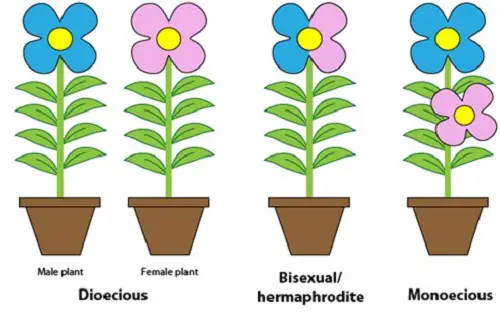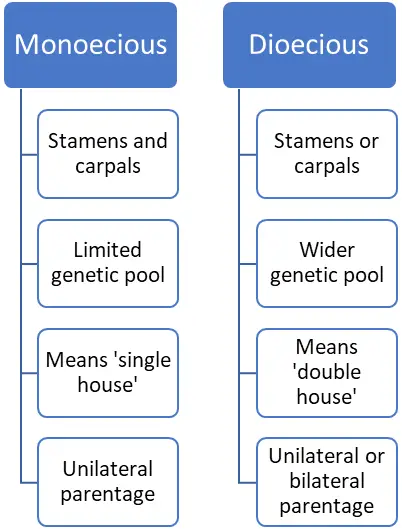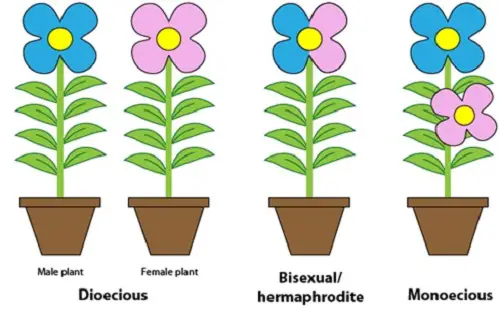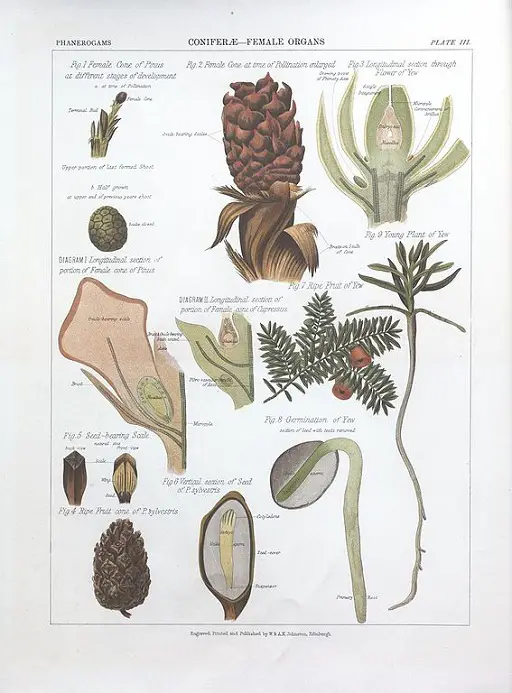
The terms monoecious and dioecious are used when discussing the reproductive variations within plants, of which there is a wide variety. The differences between these two variations are listed below.
-
Reproductive Structure
The most notable difference between the two types of plants lies in their ability to reproduce. Flowers are considered perfect when both stamens and carpels are present; this may also be referred to as being ‘bisexual’ or ‘hermaphroditic.’ When these two components exist on the same plant, it is considered monoecious, however, to make a further distinction, it is possible for a plant to possess flowers of both sexes, in which case it would be considered either simultaneously or synchronously monoecious. When the flowers are present at different times, they are considered consecutively monecious.
When the stamens and carpals occur on different plants, resulting in both female and male plants, they are considered to be dioecious. One example of this would be the European holly, which always has four stamens on the male plant and an ovary on the female plant. The female plant will also have four stamens, which serve no functional purpose. Only females can produce fruit or berries. In rare instances, a dioecious plant can undergo sex-switching. The Arisaema Triphyllum will produce all or mostly male flowers while small, but as the plant grows over the span of years, the male flowers will be replaced with female flowers. For this reason, this species will move through different phases from a nonsexual juvenile to a the young phase in which all plants are male. The larger ones are may contain a mix of male and female flowers (essentially making it monoecious for a small period of time), and the largest and oldest plants will have mostly female flowers.
-
Survival and Genetic Consequences
The differences in the availability and process of sexual reproduction for both monoecious and dioecious species leads to different selective advantages and disadvantages. Monoecious species have both sex organs, meaning that reproduction and be achieved fairly easily. They are capable of reproducing even in isolation. However, if this happens too frequently, it can lead to inbreeding and associated genetic disorders and a related reduction in genetic variation within the populations.
Since dioecious plants exist as one sex only, their ability to reproduce can largely depend upon geographic and other variables within their habitat. However, when reproduction does occur, it results in a much larger variance within the genetic material, which can lead to evolutionary advantages through adaptation.
-
Etymology
Both terms monoecious and dioecious have Greek roots, and their literal translations refer to their method of sexual reproduction. Monoecious literally means ‘single house’ indicating that both male and female parts are found on a single individual. Dioecious means ‘double house’ and refers to the fact that male flowers are on one plant and female flowers are located on another.
-
Species
Though both monoecious and dioecious flowering plants have subspecies, the majority of them are monoecious, indicating the presence of the perfect flower (with both male and female parts). One common example would be members of the conifer family, including pines. Corn is also considered monoecious, though it frequently has unisexual flowers of both sexes on the same plant. The male flowers are commonly found at the top of the plant, while the female flowers, called silks, are located on the side. Other monoecious examples include squash, walnut, oak, hazel, fir trees, alder trees, birch trees, spruce trees, beech trees, and cypress trees.
Despite being marginally less common, there are many, many examples of dioecious plants as well. Examples include Marijuana, asparagus, gingko biloba trees, papaya, willow, holly, poplar, mulberry, juniper, maple trees, ash trees, persimmon trees, willow trees, and kiwi plants, among others.
-
In Animals
While the terms monoecious and dioecious are typically used to determine plant reproductive morphology, the terms can sometimes indicate animals which have a similar reproductive structure. With monoecious animals, the egg and sperm are produced by the same organism and some can even indicate the presence of external genitals. This allows for self-fertilization. Examples of this type of monoecious species would be earthworms, slugs and jellyfish.
Dioecious organisms seem to be more common in animals, especially in mammals. Humans would be considered dioecious, along with birds, reptiles, insects. Because of the complicated nature of parentage in the animal kingdom, this type of reproduction can result in either unilateral parentage or bilateral parentage. With mammals, only about 5-10% of the species exhibit paternal care (with it being a defining characteristic for humans), with the mother providing primary care in the clear majority of species. Birds typically tend to contribute equally in care in approximately 90% of species, and in about 1% the fathers become the sole caregiver after the eggs are laid. Paternal care also happens in several amphibian and fish species, most notably would be the seahorses, which actually keep the eggs in a pouch until they are ready to hatch. With jawfish, the male will keep the eggs in his mouth until they hatch. Sole paternal care as well as joint care structures with both parents contributing exist solely with dioecious animals. Theoretically, this occurs to offset the higher energy demanded from the mothers, and would contribute to an increase in survival, something which would not be possible for monoecious organisms.













Leave a Reply